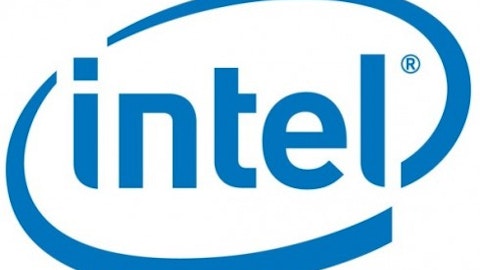McDonald’s Corporation (NYSE:MCD) has focused on becoming one of the most trusted brands in the world, and the company will be moving ahead to make its brand even stronger with its “Plan to Win” framework. This framework is focused on five pillars of growth: People, Product, Place, Price and Promotion. The company has taken initiatives that will impact all these pillars of growth. Store expansions and remodeling will increase its store base and create a better store environment for its employees and customers. New product launches and value offerings have played a critical role in comparable sales growth and will continue to do so. It will also use advances in technology to improve its service through increased promotional tactics. Now let’s discuss these points in detail.
Store expansions and remodeling

New product launches and value offerings
New product launches and value offerings have driven the same store sales in the recently-reported May comps. Its global comps were up by 2.4% in May, as compared to the consensus estimate of 2.1%. In the US, premium McWraps and Egg White Delight breakfast sandwiches were the main comp drivers and were spurred by national advertising. The company also launched new toppings for its classic Quarter Pounder burgers in June, giving customers a choice of Bacon Habanero Ranch, Deluxe and Bacon and Cheese versions of the sandwich. In the European market, France and Germany are experiencing good sales with the “Casse Croute” menu and sandwich/drink combos in the value segment. The Chinese market is also recovering and will be back on track soon after the effects of the avian flu.
Promotion and use of advanced technology
The company has focused on promotional initiatives and the use of advance technology to improve sales as well. In the US, a nationwide advertising campaign for its premium McWraps has helped them to perform well in the market. It has used couponing as well and recently promoted its new Quarter Pounder products using a national BOGO offer. It has also focused on improving efficiency with mobile ordering and delivery in the APMEA market and with self-ordering kiosks in Europe. Its global point-of-sale system rollout will help the company to deliver orders more quickly as well. It has focused on creating a strong brand with better accessibility and this technological advancement will help it to drive long-term growth.
Peer analysis
In the quick service restaurants segment, two other major players that compete with McDonald’s Corporation (NYSE:MCD) are Yum! Brands, Inc. (NYSE:YUM) and Burger King Worldwide Inc (NYSE:BKW).
Yum! Brands is moving ahead with strong store growth plans across its brands in emerging markets such as China and India. It has opened 380 stores in the first quarter, and 88% of this development is in the emerging markets. In China, it has acquired an additional 66% interest in Little Sheep, with a strategy of building a leading position across each category. It has plans to maintain its double-digit unit growth in the country. Taco Bell is the leading growth driver for the company in the U.S. market due to successful product launches such as the Doritos Locos Taco and the Cantina Bell Menu. It is expected to continue its sales growth with unit growth momentum and strong brand creation across multiple segments.
Burger King Worldwide is moving toward a completely franchise-based business model. The company has completed the transformation in 97% of its stores and will complete them all by the end of 2013. It also has store expansion plans, with new franchises and joint ventures in Mexico, Columbia and South Africa. It is also re-imagining its stores and has completed 20% of them. The re-imagining has helped franchise stores to achieve sales growth of around 10% to 15%, and this will be a growth driver for the company after its completion in 2015. Earlier this year, the company launched the Whooper Junior at a $1.29 price point and will be focusing more on value offerings to attract customers to the stores.
Financials
| Company | P/S ratio | Op. Margin | 1 Yr. Fwd. P/E |
|---|---|---|---|
| McDonald’s | 5.51 | 31.25% | 15.77 |
| Yum! Brands | 3.72 | 29.51% | 18.86 |
| Burger King | 2.9 | 19.21% | 22.67 |
Source: Google Finance and Yahoo! Finance
McDonald’s Corporation (NYSE:MCD) has reported the highest operating margin among the three mentioned peers with 31.25%, along with the lowest one-year forward price-to-earnings ratio of 15.77. Yum! Brands has an operating margin of 29.51%, with relatively moderate forward price-to-earnings ratio of 18.86. Burger King has the lowest price-to-sales ratio of 2.9, but it also has an operating margin of 19.21%.
Conclusion
McDonald’s Corporation (NYSE:MCD) is expanding its store base around the world, but the APMEA market will have the largest store growth this year. The company looks to increase same-store sales growth through new product launches and aggressive promotions, using advances in technology to improve its efficiency. All of these initiatives are expected to drive sales growth of the company in the long term, so I recommend a “buy.”
Ash Sharma has no position in any stocks mentioned. The Motley Fool recommends Burger King Worldwide and McDonald’s. The Motley Fool owns shares of McDonald’s.
The article Will Unit Expansion and New Product Launches Drive Sales Growth for McDonald’s? originally appeared on Fool.com and is written by Ash Sharma.
Ash is a member of The Motley Fool Blog Network — entries represent the personal opinion of the blogger and are not formally edited.
Copyright © 1995 – 2013 The Motley Fool, LLC. All rights reserved. The Motley Fool has a disclosure policy.




